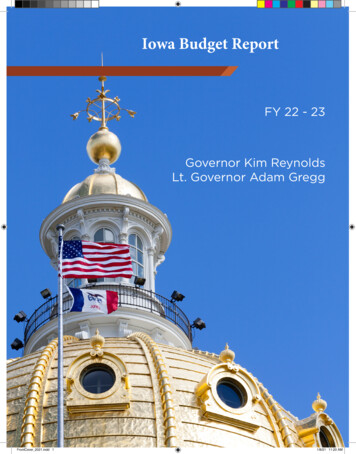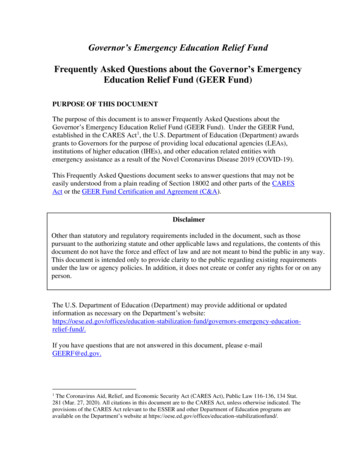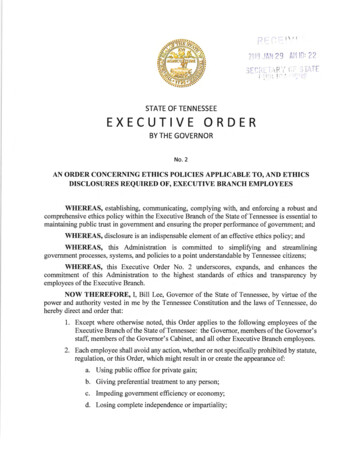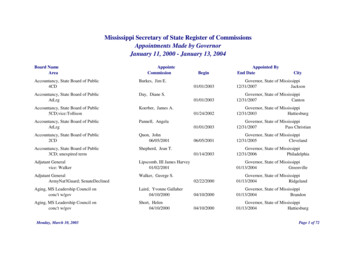
Transcription
State of New JerseyThe Governor’sFY 2012 BudgetBudget Summary Chris Christie, GovernorKim Guadagno, Lieutenant GovernorAndrew P. Sidamon-EristoffState TreasurerRobert L. PedenDeputy DirectorCharlene M. HolzbaurDirectorJacki L. StevensAssistant DirectorOffice of Management and BudgetFebruary 22, 2011This document is available via the Internet at http://www.state.nj.us/treasury/omb
Table of ContentsTABLE OF CONTENTSPageSection I: The Christie Reform Agenda: It’s Time To Do The Big Things .A Letter from Governor Christie .11Section II: New Jersey’s Fiscal Outlook: The Difficult Path to Recovery .New Jersey’s Economic Outlook for FY 2012 .Common Challenges: Comparison to United States and Other States .Revenue Forecast .34711Section III: The New Normal in Budgeting .Christie Reform Agenda: Achieving Budget Reform in “The New Normal” .Building Blocks for the FY 2012 Budget .Fiscal Year 2012 Highlights: The New Normal in Budgeting .Budgeting from the Bottom-Up to Fund Key Priorities .1718192021Section IV: FY 2012 Solutions: It’s Time To Do The Big Things .The Christie Reform Agenda: It’s Time To Do The Big Things .Creating Jersey Jobs and Providing Responsible, Sustainable Tax Relief .Making 2011 the Year of Education Reform in New Jersey .Taking on the Third Rail: Bringing Fiscal Sanity to New Jersey’s Pensionand Benefits Systems .Off-Budget Spending Discipline – Boards, Authorities, Commissions.27282934Section V: A Commitment to Transparency, Accountability and Results . The Annual Tax Expenditure Report .The Governor’s Performance Budgeting Initiative: Budgeting for Results .Allocation of Budget by Core Mission Areas .53545455Section VI: Summary Charts .59Section VII: Appendix .754151
Section I: The Christie Reform Agenda:It’s Time To Do The Big ThingsA Letter from Governor Chris ChristieTo the People of New Jersey, and the Senate and Assembly of the New Jersey Legislature:Enclosed is the Governor’s Fiscal Year 2012 Budget: A Commitment to Rebuilding New Jersey. Thisbudget keeps our promise to the people of New Jersey to put forward a constitutionally-balanced statebudget that maintains fiscal discipline in these difficult economic times. After closing an unprecedented 11billion projected deficit in last year’s budget, this year’s budget proposal continues down the path of fiscaldiscipline and responsibility. It firmly cements a departure from an engrained Trenton culture that insists onirresponsible, autopilot spending regardless of program effectiveness and is ignorant of the devastatingfiscal impact on our State’s economic health.With this budget we are creating The New Normal in Trenton.For the second consecutive year, we have provided a budget that reduces government spending; does notraise taxes on New Jersey families; that increases New Jersey’s competitiveness; that makes difficultdecisions necessitated by new economic realities; and that continues to fund the key priorities to protectvulnerable New Jerseyans and secure our state’s future growth and prosperity.It is also an overview of our Administration’s reform agenda aimed squarely at taking on the big issuesfacing New Jerseyans – bringing fiscal sanity to our state’s out-of-control pension and benefits systems,reforming our education system to ensure every New Jersey child has a great education, and providingcritical tax relief to families.The fiscal year 2012 budget before you spends 29.4 billion – 2.6 percent less than the adjusted fiscal2011 appropriation for state spending – while providing funding for essential services, programs andpriorities, including: Tax relief for families by doubling the homestead benefit; Programs and funding to protect the New Jerseyans most in need, such as increased hospitalfunding and student financial assistance; Targeted tax cuts and incentives to grow the economy and create Jersey Jobs; Increased education aid to every school district in New Jersey; Fulfilling the statutory commitment to make the state’s pension fund payment; and A consistent level of municipal aid.Last year, we made a commitment to decisively change the direction of New Jersey to put our state on abetter, more sustainable path and press ahead on the road to growth. The fiscal year 2011 budget was thefirst step down that road; today, we are continuing to make progress, keeping faith with New Jersey familiesand making the difficult decisions that are now before us. This budget represents those principles, whilemaintaining our commitment to do all that we can to care for those in need.1
The Day of Reckoning that has struck New Jersey was decades in the making and it cannot be undone in asingle year. In order to turn around New Jersey’s economy, create meaningful jobs and restore our hopefor the future, we must not waiver in our commitment to fiscal discipline and fundamental reform. One thingis certain: we will not drift back towards the edge of fiscal disaster by embracing the old way of doingthings. Instead, we will continue to turn Trenton upside down by challenging the status quo, conventionalwisdom and special interests.Our future is contingent on the decisions we make today which is why we must not relent in our obligationto responsibly budget, promote job growth for our families and leave a legacy of prosperity and affordabilityfor our children.Sincerely,2
Section II: New Jersey’s Fiscal Outlook:The Difficult Path to RecoveryNew Jersey’s Economic Outlook for Fiscal Year 2012Common Challenges: Comparison to the United States and Other StatesRevenue ForecastSECTION I: THE CHRISTIE REFORM AGENDA:IT’S TIME TO DO THE BIG THINGS3
New Jersey’s Economic Outlook for Fiscal Year 2012The Difficult Path to New Jersey’s RecoveryNew Jersey was especially hard hit by the national recession, but it is beginning to show signs of recovery.Between December 2006 and December 2010, New Jersey lost 225,800 private sector jobs, or 6.6% of theworkforce. Unemployment reached its highest level in 33 years, while the housing market collapsed andState revenue declined precipitously. The magnitude of the gap in government finances created by thiscrisis was great. Through difficult decisions and a new focus on discipline and fiscal responsibility, NewJersey has begun to see signs of progress and recovery, and citizens are showing a renewed optimismabout the direction of the State.The State’s economy is crawling back from the severe recession of 2007 to 2009. The recovery is likely tocontinue unabated, but at a painfully slower pace than experienced during past economic expansions.But job growth, while beginning to improve, has been less robust. Private employment has stabilized, whichwas a marked improvement from 2008-2009. New Jersey lost 108,500 private sector jobs in 2008 and121,200 in 2009. In contrast, from January 2010-December 2010, New Jersey stemmed the loss of jobsand gained a total of 8,200 private sector jobs.Employment did grow in a number of sectors, most notably at temporary help firms. (Growth in temporaryhiring is usually regarded as a leading indicator of more permanent job gains.) Additionally, finance andhealth care industry employment also inched higher.Some parts of the State have fared better than others during the slow recovery. Most notably, PassaicCounty saw a robust, nearly 2% increase in the number of jobs between the middle of 2009 and the middleof 2010. Among other counties with employment over 75,000, Atlantic, Mercer, Ocean, Somerset, andUnion also saw job growth during that time period.Private sector wages are finally starting to rise. State gross income and corporate business tax collectionsare beating the estimates in last year’s Budget, an indicator that both paychecks and profits are growing.4
Growth of New Jersey Private Wagesand Salaries(Percent Change from One Year Earlier)10%8%6%4%2%0%-2%-4%-6%-8%-10%1st Qtr. 2nd Qtr. 3rd Qtr. 4th Qtr. 1st Qtr. 2nd Qtr. 3rd Qtr. 4th Qtr.200820091st Qtr. 2nd Qtr. 3rd Qtr.2010Source: The U.S. Bureau of Economic AnalysisHigher incomes will result in higher spending by New Jersey residents and businesses -- at our stores andon housing and construction -- and by visitors to the State. Higher spending should also be reflected in realjob growth. Moderate gains in private sector employment in 2011 and further growth in 2012 appear to beahead, though gains will not be sufficient to erase the job losses experienced during the recession.Looking ahead to 2011 and 2012, the prospects are good for barriers to growth to diminish. Incomegeneration should be strong, with New Jersey and New Jersey-area companies and firms continuing tohold their own and contributing higher profits needed to drive the national recovery. Earnings also are risingfor Garden State residents who work out of state. The State’s unemployment rate should continue todecline. Joblessness figures already have moved down one full percentage point from their recessionpeaks. In 2011, we should see unemployment fall because of real growth in the number of jobs available.5
New Jersey Unemployment andNonfarm Payroll Employment4,10012%4,05010%4,000In 0 2001 2002 2003 2004 2005 2006 2007 2008 2009 2010* 2011**2012**Nonfarm Payroll Employment%Unemployment Rate* Preliminary** ProjectionsSource: U.S. Bureau of Labor AnalysisNonetheless, other indicators show other underlying concerns if New Jersey’s fiscal house is not put inorder, which is why Governor Christie continues to focus on maintaining fiscal discipline. Financialproblems and debt continues to beset many households and small businesses. Federal Reserve Bank ofNew York calculations from credit bureau data show that New Jersey borrowers owed an average of 60,800 in debt at the end of last year, well above the national average of 47,400. These private debtburdens place New Jersey citizens at risk if economic and financial conditions deteriorate.New Jersey is still working to recover from the collapse of the housing market. The market is beginning toshow signs of stabilizing, but is still glutted with foreclosed properties. The New York Federal Reservereports that the fraction of New Jersey mortgages more than 90 days’ delinquent is 7.8%, which iscomparable to the high U.S. figure.Looking ahead to growth sectors in the State’s economy, New Jersey should be in a fortunate position. Ourstate retains large concentrations of employers in the life sciences, telecommunications, and finance -sectors likely to grow at a faster clip as the national economy expands.These sectors employ highly-skilled, well-educated, and generally highly-paid workers who pumpsignificant revenue into local economies. New Jersey is one of the national leaders in the share ofpopulation with a post-graduate education. That concentration of brainpower should continue to attract6
even more employers of highly-educated workers, if other issues such as the burden of taxation areaddressed.Our logistics sector will benefit if national and international commerce continue to revive. Sectors thatbenefit when household incomes grow -- most notably retailing, travel, and entertainment -- should also firmup. We expect some stabilization or modest improvement in the construction sector, but the timing andextent of any recovery will depend on how rapidly excess residential and commercial space is absorbed bythe market.Common Challenges: Comparison to the United States and Other StatesThe United States is entering a period of stronger output growth and more pronounced gains inemployment. Toward the end of calendar year 2010, indicators showed substantial growth in consumerspending, ongoing strong gains in industrial output, and increased capital spending. All these developmentssuggest the maturing of the initially-hesitant economic recovery. Positive forces that have been working tospur growth include the Federal Reserve’s maintenance of near-zero short-term interest rates; a pickup inexport demand (stemming in part from sharp growth in the developing world); and the continuing benefit ofearlier federal tax cuts and spending increases flowing through the economy.At long last, the recovery process is bringing substantial improvements in consumer and businessconfidence, higher corporate earnings, and, through its effect on the stock market, higher householdwealth. These positive developments have been reflected in faster growth of household and businessspending. It is a safe bet that the improvement will continue, aided in part by the recent cut in federalpayroll taxes.The headwinds from continuing credit problems, the painfully slow workout of the troubled home mortgagesituation, and fragile state and local government finances will continue to depress growth, as will Europeandebt concerns and the potential for Middle East turmoil. Uncertainties about financial and health carepolicies will also weigh on confidence and output.National labor markets have seen some modest improvement, with the unemployment rate drifting downfrom its peak and the job count beginning to increase. Businesses have been reluctant to hire until they areabsolutely certain that the recovery will last, and the expansion of output has so far been primarily the resultof gains in productivity and longer workweeks, not hiring of more workers.Likewise, uncertainty and unease about the economic impact of federal policies remains a significantbarrier to job growth. Apprehensive business leaders are reluctant to invest because of historically high andgrowing federal debt, rising federal spending without sufficient revenue to support the increases, and thelooming prospect of increased taxation and costly regulation.7
New Jersey in Comparison to Other StatesNew Jersey residents are not the only ones whose friends, neighbors and relatives have been enduringunemployment and mortgage defaults. Citizens of all states are struggling to put the recession behindthem, but the effects linger just the same. Just like New Jersey’s Governor and legislators, nearly everystate government official is coping with reduced revenue, pension shortfalls, and out-of-control health careexpenses.New Jersey’s December 2010 unemployment rate of 9.1%, though higher than that of some of itsneighbors, was comparable to that of the nation as a whole. The State’s rate was matched or exceeded by21 other states. Only five relatively small states (Nebraska, New Hampshire, North Dakota, South Dakota,and Vermont) had unemployment rates under 6%. Ten states — including California and Florida, the mostpopulous and the fourth most populous states — had rates above 10%. Most states saw only modestgrowth in available jobs over the course of 2010.State governments are recovering, but still grappling with severe budget problems. As in New Jersey,legislators and governors in other states are trying to live on less revenue than just two or three years agobecause their economies are still operating at far below pre-recession levels. Federal stimulus aid, a nonrecurring revenue patch, has expired; unemployment insurance trust funds need to be replenished; andthe pressure to restore expenditures persists even as the difficult times continues. Legislators andgovernors from coast to coast are faced with choices that are as tough or tougher than last year. Like NewJersey, many are trying to cut public sector employment and restrain government salaries and benefits.Unlike most states, however, New Jersey began to enact strong fiscal discipline a year ago.Unfunded Liabilities in New Jersey’s Pension and Benefits Systems Remain a Severe ProblemAlmost all states are facing major issues in financing employee pensions. The Pew Foundation reportsthat in 2008, the 50 states collectively had only 2.35 trillion in assets to finance an estimated 3.35 trillionin future employee retirement benefits. Since then, given the generally reduced levels of pension fundmarket values and continuing growth in the expected retirement bill, the discrepancy has grown. Manystates are considering major changes to their retirement systems, in an effort to reduce the cost burden ontaxpayer households and businesses.8
Pension Funding Ratio: NJ Near the Bottomversus Neighboring States & the U.S. 60.0%51.9%40.0%20.0%0.0%New Jersey * DelawareConnecticutNew York PennsylvaniaU.S.* This represents NJ’s combined state and local funded ratio as of 6/30/2010Source: NJ’s aggregate funded ratio as of 6/30/2010. Other states’ data from the Public FundSurvey– DE State Employees as of 6/30/09; CT State Employees Retirement System (ERS) as of6/30/09; NY State & Local ERS as of 3/31/10; & PA State ERS as of 12/31/09. U.S. represents theaggregate average of the 127 state and local plans in the survey.Skyrocketing medical costs are a burden on states. Medicaid expenses are growing because of highunemployment, and the end of temporary federal support for the Medicaid program will leave huge holes inmany state medical care budgets.Just as important for state and local budgets, costs are rising for employee and retiree medical benefits.The expense of meeting promises of support for health care is proving to be much larger than anticipatedwhen the promises were first made because medical costs as a whole have risen so much, and becausepeople are living longer and consuming more health care dollars. As the nation ages, this demand will growat an even faster pace. Thus, the total medical bill for the nation and the states continues to rise steeply.State taxpayers across the nation are on the hook for a huge portion of the bills. To be sure, states acrossthe nation are dealing with hard times and facing hard choices. New Jersey will not be alone in the need totake bold and controversial steps to address the problems brought on by the recession and lingeringfinancial imbalances.9
Health Benefit Costs as a Percent of the State BudgetHave Doubled in the Last 10 Years10%9%8%% OF TOTAL BUDGET7%6%5%4%3%2%1%0%FY 01FY 02FY 03FY 04FY 05FY 06FY 07FY 08FY 09FY 10FY 11FY 12**Without the Administration’s proposed health reforms, health costs in FY12 would represent 9% of the State BudgetLikewise, rising costs in New Jersey’s generous public employee health benefits system continues to addspending pressure on the State’s budget. The State of New Jersey will spend 2.4 billion in fiscal year 2012on employee and retiree health benefits. Without reform, these costs – which have already doubled as apercentage of the State budget since 2001 – would rise 40% over the next four years.10
Revenue ForecastBased on estimates from the Department of the Treasury, Office of Revenue and Economic Analysis, NewJersey’s total revenues for fiscal year 2012 will be close to 29.4 billion, including the Governor’s proposedtax cuts. Total fiscal year 2012 revenues are 1.11 billion or 4% above the revised fiscal year 2011projected level. Fiscal year 2012’s projected growth in revenues is consistent with ongoing improvement inthe State’s economy. New Jersey’s economy is expected to grow steadily in calendar year 2011, withgradual improvements in labor market conditions, and gain additional momentum in 2012. On the whole,the outlook for the State’s economy is roughly in line with forecasts for national trends, and the projectedimprovement in revenues will also be in line with national developments. The start of significant andongoing tax reform in New Jersey will bring greater economic growth.FY 2012 Revenues(In Millions)Change toFY 2011FY 2011FY 2012Approp. ActRevisedEstimate* 9,855 tal 6.8 ,162 28,26229,374 1,212* FY2012 Revenue Estimate includes 200 million of tax cuts** All Sales Tax and Corporation Business Tax on Energy are included in Other11 %673 10,528Approp. Act4.3 %
History of Total RevenuesFY 2012 Approximates FY 2006*(In Billions) 33.0 32.6 32.0 31.2 31.0 30.0 29.0 29.4 28.9 28.7 27.9 28.0 28.2 28.3 27.0 26.0 25.0FY2006CAFRFY2007CAFRFY2008CAFRFY2009CAFR* Not including federal stimulus aid** FY2012 Estimate includes 200 million of tax cutsCAFR – Comprehensive Annual Financial Report12FY2010CAFRFY2011Approp.ActFY2011 FY2012Revised Estimate**
Sales TaxThe forecast of 8.078 billion in sales tax revenue for fiscal year 2012 is an increase of 303 million overthe revised fiscal 2011 level. The 3.9% growth primarily reflects continuing improvement in consumerspending as the economic recovery strengthens. New Jersey’s sales tax revenues will also benefit aseconomic expansion takes hold, given the likelihood that consumer spending growth on discretionaryproducts will be larger than in exempt categories.Sales Tax(In Billions) 9.0 8.181 8.395 8.0 7.0 7.829 7.723 7.775 8.078 7.523 6.766 6.0 5.0 4.0 3.0 2.0 1.0 0.0FY2006CAFRFY2007CAFRFY2008CAFRFY2009CAFRFY2010 FY2011CAFR Approp.ActFY2007 tax increases:- increased Sales Tax rate from 6% to 7%- broadened Sales Tax baseFY2009 includes 142.5 million received under the Amnesty programFY2012 includes 2.5 million in tax cutsSales Tax excludes the tax on energyCAFR – Comprehensive Annual Financial Report13FY2011 FY2012Revised Estimate
Corporation Business TaxThe Corporation Business Tax (CBT) forecast of 2.430 billion for fiscal year 2012 is 110 million abovethe revised fiscal 2011 level. National corporate profit growth will tail off as gains in employeecompensation begin to weigh on earnings. Earnings for federal tax purposes will be held down substantiallyin 2011 as a result of tax law changes. Nevertheless, New Jersey’s corporate tax revenues are projected tobe boosted not only by recovering corporate profitability, but also by a reduction in refunds and loss carryforwards, as the impact of the recession on State taxable earnings and liabilities fades.Corporation Business Tax(In Billions) 3.5 3.0 2.997 2.838 2.993 2.622 2.430 2.5 2.320 1.999 2.0 2.145 1.5 1.0 0.5 Y2011FY2011CAFR Approp. Act RevisedFY2009 includes 392.6 million received under the Amnesty programFY2011 4% Surcharge expiredFY2012 includes 100.2 million in tax cutsCorporation Business Tax excludes the tax on energyCAFR – Comprehensive Annual Financial Report14FY2012Estimate
Gross Income TaxFor fiscal year 2012, the Gross Income Tax is expected to yield approximately 10.5 billion, a 452 millionincrease over the revised estimate for fiscal year 2011, but trailing below the fiscal year 2008 peak of 12.6billion. The projected 4.5% increase, based on moderately higher-than-expected receipts observed to datefor fiscal 2011, primarily reflects growth in income. New Jersey’s total income that is subject to the incometax apparently bottomed out in tax year 2010 after the steep decline of 9.5% in tax year 2009, and it isanticipated to grow moderately in 2011 and 2012.Aside from the rise in total income, it is important to note that households reporting over 100,000 intaxable income (only 20% of New Jersey taxpayers) account for more than 85% of the State’s income taxrevenue. The earnings of these households apparently dropped dramatically during the recession, as thefinancial industry contracted and other firms cut back on incentive pay and bonuses. These declinesexerted a disproportionate impact on New Jersey’s revenues due to our highly progressive income tax. Itappears that upper income household earnings have recently started to rebound. Income of householdsearning more than 100,000 is estimated to have grown by 4.6% in tax year 2010, and the pace isexpected to increase to 7.8% in tax year 2011. While these rates are still significantly below the double-digitannual gains experienced from 2004 to 2007, the positive swing will be a growth factor for income taxrevenues. Nonetheless, the level of income tax revenues forecast for both fiscal years 2011 and 2012 issensitive to the still uncertain flow of final payments and refunds for tax year 2010, which follows theexpiration of tax year 2009’s one-year tax hike on high income taxpayers and small businesses.Gross Income Tax 14.0 12.605 13.0 12.0 11.0(In Billions) 11.727 10.476 10.507 10.528 10.323 10.0 9.855 10.076FY2011Approp. ActFY2011Revised 9.0 8.0 7.0 6.0 5.0 4.0 3.0 2.0 1.0 AFRFY2012EstimateFY2009 Incremental change in EITC ( 60 million); Tax Amnesty of 88.9 millionFY2010 Incremental change in EITC ( 9.9 million); EITC federal reimbursement ( 150 million); Millionaire’stax enactedFY2011 Income tax surcharge expiredFY2012 includes 23.0 million in tax cutsCAFR – Comprehensive Annual Financial Report15
16
Section III: The New Normal in BudgetingChristie Reform Agenda: Achieving Budget Reform in the “New Normal”Building Blocks for the FY 2012 BudgetFiscal Year 2012 Highlights: The New Normal in BudgetingBudgeting from the Bottom-Up to Fund Key Priorities17
Christie Reform Agenda: Achieving Budget Reform in the “New Normal”Just over a year ago Governor Christie entered office and was faced with an unprecedented budget gap.In January of 2010, New Jersey was staring down a 2.2 billion deficit for fiscal year 2010 that requireddifficult and tough solutions. Furthermore, Governor Christie still had to address an immediate 10.7 billiongap in fiscal year 2011. It was not easy, but the Governor laid out a plan to do what was necessary tostabilize the state’s finances.In many ways, the leftover mess of fiscal year 2010 was an indicator of everything wrong with New Jersey’sbudget process. The previous budget gaps, totaling a combined 13 billion, were the culmination of yearsof shortsighted policies and poor budgeting practices that ignored economic realities, failed to plan foreroding recurring revenue sources, and consistently relied on one-time revenues sources. Despitediminishing revenue, State spending increased by nearly 30% over the previous eight years. Consistentspending beyond the State’s means was emblematic of the Trenton philosophy – just continue toautomatically fund programs at previous levels without giving any thought to the effectiveness of theprogram or the overall fiscal health of the state.The hard choices that required shared sacrifice in the fiscal year 2011 Budget set the foundation for futurebudget planning. By closing a nearly 11 billion budget gap of legislated spending without raising taxes,Governor Christie hit the reset button on how budgeting works in Trenton.The Christie Administration has changed the paradigm and established a New Normal in budgeting. TheNew Normal in these difficult economic and budgetary times requires a fundamental rethinking of how andwhere the State spends scarce taxpayer dollars. Every year the Office of Legislative Services is asked todefine a projected deficit that assumes no one is actually managing the budget or setting priorities. Thisprojection is the old way of budgeting – assuming each and every program will be funded at the same levelor higher each and every year. As such, the Budget is just running its course without anyone takingresponsibility for setting priorities.18
19
But now those days of autopilot spending, and the consequential annual projection of multi-billion dollardeficits, are over. New Jersey’s State Budget is now being developed from the bottom up – setting outpriorities and funding them based on the revenue that is actually available. The New Normal means nolonger blindly funding commitments that prior legislators and governors made. Now, the New Normalmeans knowing how much revenue actually exists and then setting priorities within the funding that isavailable.Fiscal Year 2012 Highlights: The New Normal in BudgetingGovernor Christie is proposing a fiscal year 2012 Budget of 29.4 billion, which is 2.6% less than theadjusted fiscal year 2011 appropriation for State spending.The Governor’s Budget continues on the path of fiscal restraint by including a series of critical reforms,department savings, government performance enhancements, and focused tax cuts, while funding keypriorities which protect many of New Jersey’s most vulnerable residents.Governor Christie’s Fiscal Year 2012 Budget: Fiscal Restraint While Funding Priorities Reduces spending for the second consecutive year: a year-over-year reduction of 2.6%; Increases education aid to every school district in New Jersey by a total of 250 million; Fulfills the statutory commitment to make a 506 million pension fund payment ahead of time, byproposing to make the payment before the end of fiscal year 2011. This represents the firstfunding provided for the defined benefit plans since fiscal year 2009; Provides 200 million in job
1st Qtr. 2nd Qtr. 3rd Qtr. 4th Qtr. 1st Qtr. 2nd Qtr. 3rd Qtr. 4th Qtr. 1st Qtr. 2nd Qtr. 3rd Qtr. 2008 2009 2010 Higher incomes will result in higher spending by New Jersey residents and businesses -- at our stores and on housing and construction -- and by visitors to the State. Higher spending should also be reflected in real job growth.











